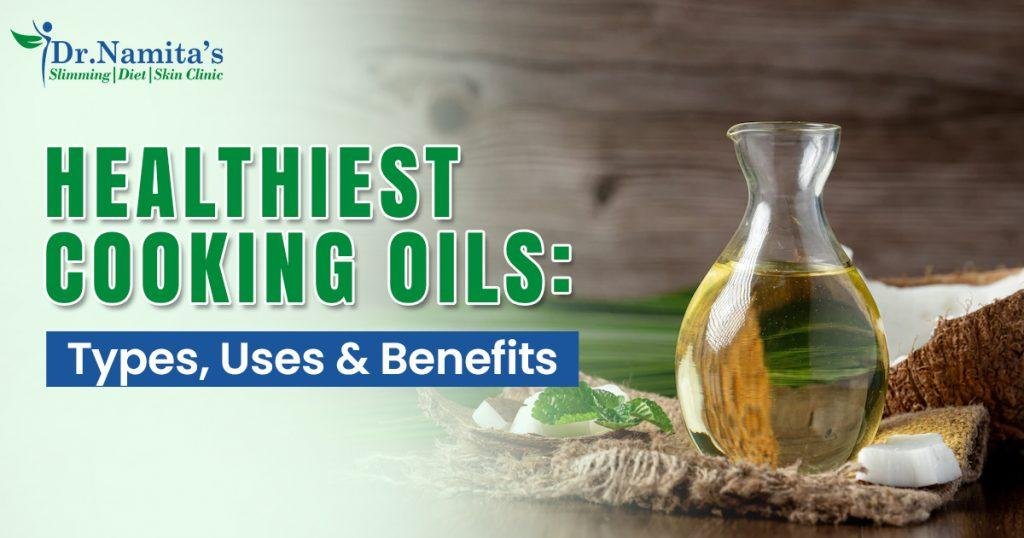Cooking oils are a culinary essential in all families, regardless of nation or cuisine.
Each location has one type of excellent cooking oil that is usually accessible from a plant source in that region.
While olive oil is used in Mediterranean cuisine, coconut oil or peanut oil is used in Caribbean food.
Contrary to common opinion, you do not need to stop using your usual cooking oils in order to reduce fat or lose weight. Even though oils are essential fats, the type of oil used is just as important as the quantity. The finest cooking oil is determined by what and how you want to cook with it. (Best Nutritionist in Noida)
To determine the best cooking oil for health, evaluate the cooking method, such as frying, baking, stir-frying, grilling, or tempering, and for each of these ways, analyse the composition of each cooking oil in terms of its smoking point and handle it properly. It’s important to understand the smoking point since it may release harmful substances into your meals to make them taste harsh and remove vital nutrients from cooked items.
Let’s have a look at the several factors that differentiate cooking oils in India: (Best Diet Clinic in Noida)
- COOKING OIL STABILITY
The tendency of the oil to resist reacting with oxygen and breaking down to produce free radicals defines its stability. The oxidative stability of cooking oils is influenced by three major factors: fat ratio, antioxidant content, and degree of refinement.
- a) Fat ratio: Edible oils are mostly fat, which has distinct chemical linkages depending on whether they are plant-based (like coconut oil) or animal-based (like butter).
Let’s go over the different forms of fat;
Saturated Fatty Acids (SFAs)
Saturated fatty acids, in particular tropical oils like coconut and palm oil and animal fats like lard or butter, solidify at room temperature because they lack a double bond and have hydrogen atoms filling up or “saturating” their carbon chain. Though they have a pleasant flavour, saturated fats should only be ingested in moderation—ideally, no more than 10% of the daily calories allowed—because they can elevate blood cholesterol levels and increase the risk of heart disease.
Unsaturated Fatty Acids
Even unsaturated lipids can come from either plants or animals. However, cooking is healthier when done more frequently since it lowers blood pressure, inflammation, and bad cholesterol while still giving your body the nutrition it needs to grow new cells and maintain itself.
Monounsaturated Fatty Acids (MUFAs)
Avocado, almonds, olive, and peanut oil all include monounsaturated fatty acids, which lack two hydrogen atoms, have one double bond between their two carbons, and are stable and resistant to high temperatures.
Polyunsaturated Fatty Acids (PUFAs)
Because they lack many hydrogen atoms and have two or more double bonds, polyunsaturated fatty acids are more likely to oxidize. Omega-3 and omega-6 PUFAs are found in fish oil, which is also high in vitamin E. Soybean oil, corn oil, and sunflower oil are examples of plant-based possibilities.
- b) Extent of refinement
Unrefined: Unrefined cooking oils are obtained mechanically with little heat, preserving their original nutrients. They come in three varieties: virgin oil, extra virgin oil, and pure oil. The category is determined by the amount of oleic acid present and the technique of extraction used.
Extra Virgin Olive Oil (EVOO), comprises only 1% oleic acid and is derived from first pressing with no additional additives or heat.
Virgin olive oil, like EVOO, is extracted from the initial pressing, but it contains 3% more oleic acid.
Pure or normal olive oil is a blend of second-pressed and processed olive oil. It is still referred to as ‘pure’ since it has no additives. With an oleic acid level of 3-4%, it is clearly of lower quality than EVOO and virgin olive oil.
Refined: Refined cooking oils are created through very complex mechanical and chemical procedures. Modern extraction is made up of multiple phases. Manufacturers refine oils primarily to achieve neutral flavor, a longer shelf life, and a high smoke point. Some oils are inedible, and refining is required since it reduces oil stability by removing natural antioxidants and exposing the oil to heat.
- b) Antioxidant content
Antioxidants, as their name implies, defend against oxidation, a process that occurs more quickly when oil is exposed to high heat over a longer length of time. Some of the best cooking oils contain natural antioxidants, such as linseed oil, while others contain synthetic antioxidants.
- SMOKING POINT OF COOKING OIL
The smoking point of fatty acids is the temperature at which oil or fat begins to smoke and decompose, causing critical nutrients to be lost and dangerous toxic components to be produced. Many kitchen catastrophes can be avoided if the proper oils are used for a certain cooking method.
The greatest cooking oils have extremely low smoke points and should be used as a salad dressing.
5 THINGS TO CONSIDER WHEN SELECTING THE BEST COOKING OILS FOR A HEALTHY HEART AND MIND
According to the USDA Dietary Guidelines, oils are an important source of essential fatty acids and vitamin E and must be included in a well-balanced diet. Dietary fats aid in nutritional absorption, nervous system development, and energy production in our bodies. (Top Dietician in Noida)
To assist you in identifying and selecting superior cooking oil, the following characteristics should be looked for on any edible oil label before purchase:
- High Omega-3 content
- Omega-6 to Omega-3 ratio
- Unsaturated Fatty Acids
- Cooking Method
- Trans fat
SOURCE : https://drnamitadietclinicnoida.com/

